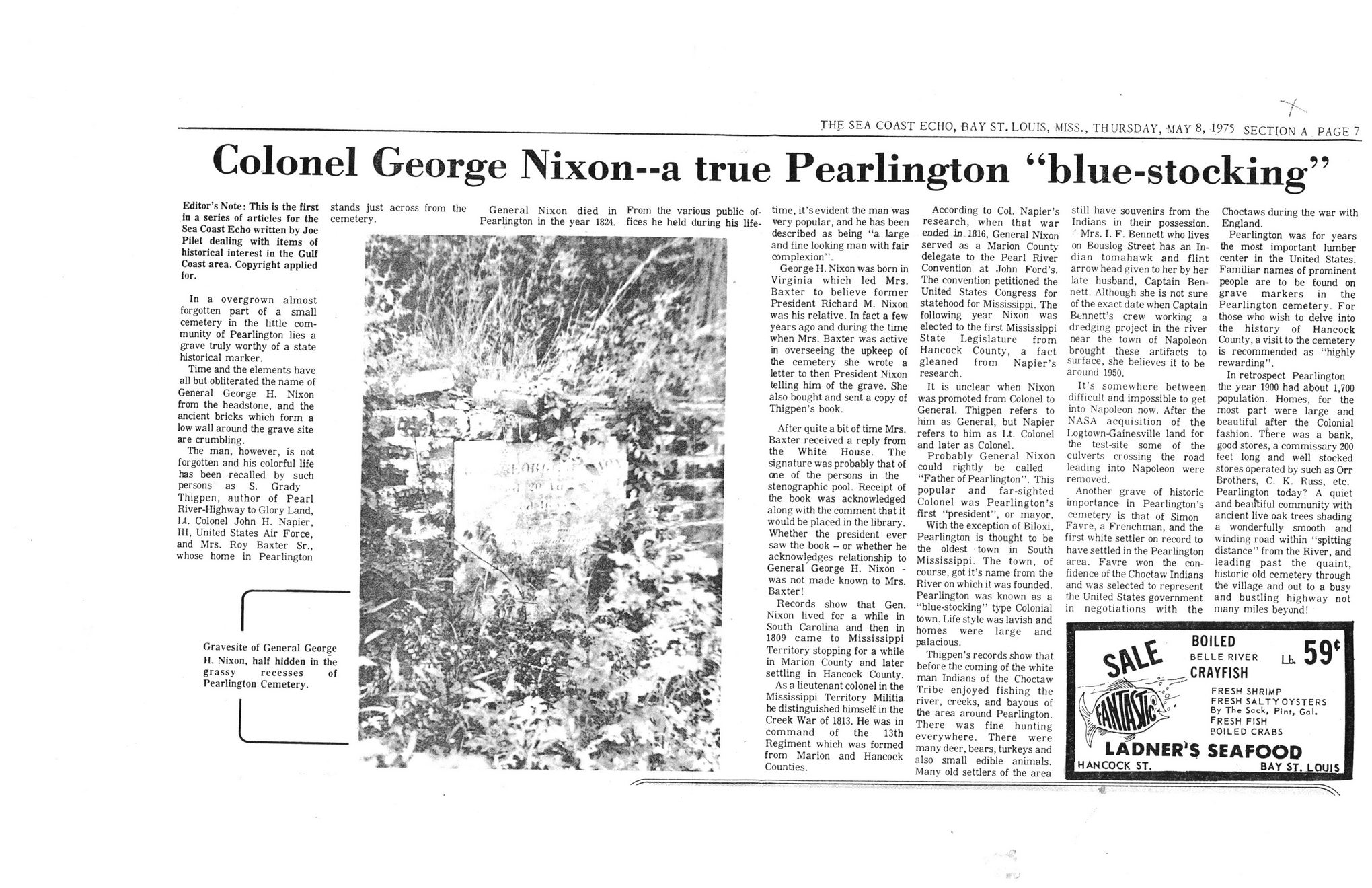This text was obtained via automated optical character recognition.
It has not been edited and may therefore contain several errors.
THE SEA COAST ECHO, BAY ST. LOUIS, MISS., THURSDAY, MAY 8, 1975 SECTION A PAGE 7 Colonel George Nixon—a true Pearlington “blue-stocking” Editor’s Note: This is the first in a series of articles for the Sea Coast Echo written by Joe Pilet dealing with items of historical interest in the Gulf Coast area. Copyright applied for. In a overgrown almost forgotten part of a small cemetery in the little community of Pearlington lies a grave truly worthy of a state historical marker. Time and the elements have all but obliterated the name of General George H. Nixon from the headstone, and the ancient bricks which form a low wall around the grave site are crumbling. The man, however, is not forgotten and his colorful life has been recalled by such persons as S. Grady Thigpen, author of Pearl River-Highway to Glory Land, Lt. Colonel John H. Napier, III, United States Air Force, and Mrs. Roy Baxter Sr., whose home in Pearlington stands just across from the General Nixon died in From the various public of-cemetery. Pearlington in the year 1824. fices he held during his life- r Gravesite of General George FI. Nixon, half hidden in the grassy recesses of Pearlington Cemetery. time, it’s evident the man was very popular, and he has been described as being “a large and fine looking man with fair complexion”. George H. Nixon was born in Virginia which led Mrs. Baxter to believe former President Richard M. Nixon was his relative. In fact a few years ago and during the time when Mrs. Baxter was active in overseeing the upkeep of the cemetery she wrote a letter to then President Nixon telling him of the grave. She also bought and sent a copy of Thigpen’s book. After quite a bit of time Mrs. Baxter received a reply from the White House. The signature was probably that of one of the persons in the stenographic pool. Receipt of the book was acknowledged along with the comment that it would be placed in the library. Whether the president ever saw the book - or whether he acknowledges relationship to General George H. Nixon -was not made known to Mrs. Baxter! Records show that Gen. Nixon lived for a while in South Carolina and then in 1809 came to Mississippi Territory stopping for a while in Marion County and later settling in Hancock County. As a lieutenant colonel in the Mississippi Territory Militia he distinguished himself in the Creek War of 1813. He was in command of the 13th Regiment which was formed from Marion and Hancock Counties. According to Col. Napier’s research, when that war ended in 1816, General Nixon served as a Marion County delegate to the Pearl River Convention at John Ford’s. The convention petitioned the United States Congress for statehood for Mississippi. The following year Nixon was elected to the first Mississippi State Legislature from Hancock County, a fact gleaned from Napier’s research. It is unclear when Nixon was promoted from Colonel to General. Thigpen refers to him as General, but Napier refers to him as Lt. Colonel and later as Colonel. Probably General Nixon could rightly be called “FatherofPearlington”. This popular and far-sighted Colonel was Pearlington’s first “president”, or mayor. With the exception of Biloxi, Pearlington is thought to be the oldest town in South Mississippi. The town, of course, got it’s name from the River on which it was founded. Pearlington was known as a “blue-stocking” type Colonial town. Life style was lavish and homes were large and palacious. Thigpen’s records show that before the coming of the white man Indians of the Choctaw Tribe enjoyed fishing the river, creeks, and bayous of the area around Pearlington. There was fine hunting everywhere. There were many deer, bears, turkeys and also small edible animals. Many old settlers of the area still have souvenirs from the Indians in their possession. Mrs. I. F. Bennett who lives on Bouslog Street has an Indian tomahawk and flint arrow head given to her by her late husband, Captain Bennett. Although she is not sure of the exact date when Captain Bennett’s crew working a dredging project in the river near the town of Napoleon brought these artifacts to surface, she believes it to be around 1950. It's somewhere between difficult and impossible to get into Napoleon now. After the NASA acquisition of the I/Ogtown-Gainesville land for the test-site some of the culverts crossing the road leading into Napoleon were removed. Another grave of historic importance in Pearlington’s cemetery is that of Simon Favre, a Frenchman, and the first white settler on record to have settled in the Pearlington area. Favre won the confidence of the Choctaw Indians and was selected to represent the United States government in negotiations with the Choctaws during the war with England. Pearlington was for years the most important lumber center in the United States. Familiar names of prominent people are to be found on grave markers in the Pearlington cemetery. For those who wish to delve into the history of Hancock County, a visit to the cemetery is recommended as “highly rewarding”. In retrospect Pearlington the year 1900 had about 1,700 population. Homes, for the most part were large and beautiful after the Colonial fashion. There was a bank, good stores, a commissary 200 feet long and well stocked stores operated by such as Orr Brothers, C. K. Russ, etc. Pearlington today? A quiet and beaiJtiful community with ancient live oak trees shading a wonderfully smooth and winding road within “spitting distance” from the River, and leading past the quaint, historic old cemetery through the village and out to a busy and bustling highway not many miles beyond! BOILED BELLE RIVER CRAYFISH Lb. 59* FRESH SHRIMP FRESH SALTYOYSTERS By The Sack, Pint, Gal. fresh fish BOILED CRABS LADNER'S SEAFOOD HANCOCK ST.__________BAY ST. LOUiS

Pearlington City Document (041)